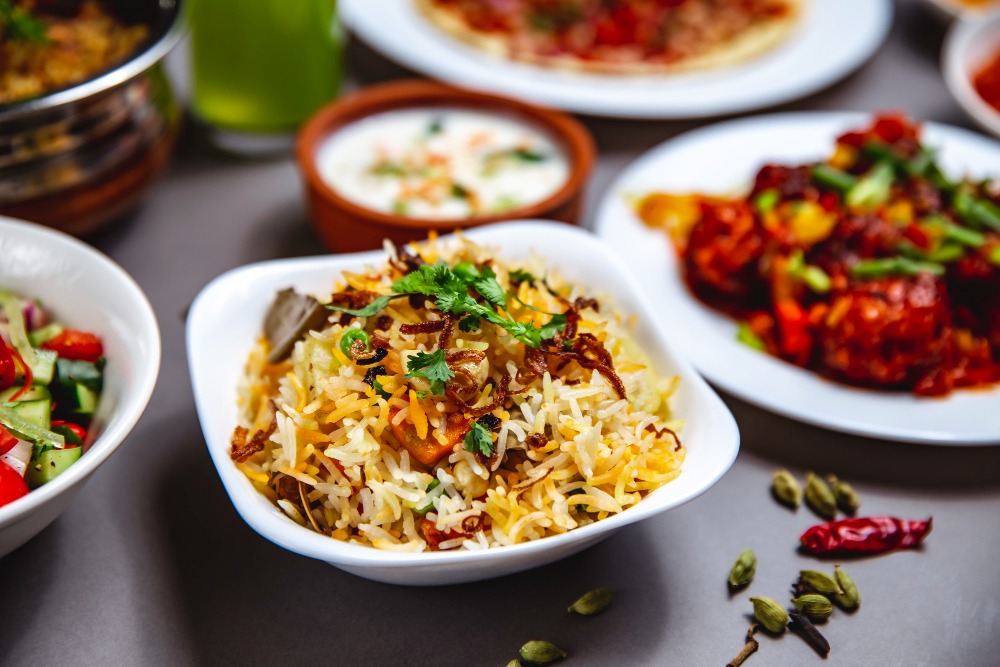Bariis: Beginner’s guide to making the perfect Somali rice

Traditionally, Bariis is served on a large platter, garnished with fried caramelised onions, nuts, or raisins, often accompanied by sauce or stew such as suqaar (stir-fried meat and vegetables) or a light potato soup.
Somali cuisine is renowned for its rich flavours, aromatic spices, and vibrant dishes, and at the heart of it lies Bariis, the traditional Somali rice dish often served at weddings, holidays, and family gatherings.
This staple meal, influenced by centuries of trade along the Somali coast, combines fragrant basmati rice with rich spices, vegetables, and sometimes meat, offering a delicious taste of East African culture.
More To Read
- Basbousa: The classic cake bringing families together
- Robots, smart tables and Somali flavours: Eastleigh’s AK’s Restaurant is the future of dining
- Trader sues to block duty-free rice imports over lack of public participation
- Nine fridge habits that could be ruining your food
- Easy to make, flavourful lentil mushroom curry with rice
- No more last-minute rush: Why meal prepping is gaining popularity in Kenya
For beginners eager to master this beloved dish, experts emphasise three key pillars: quality ingredients, proper technique, and balanced seasoning.
The foundation of authentic Bariis begins with long-grain basmati rice, prized for its fluffy texture and ability to absorb flavours.
Aromatic spices like cardamom, cloves, cinnamon, and cumin form the backbone of the dish, while garlic, onions, and sometimes raisins or fried nuts add depth and texture.
Many Somali households also include saffron or turmeric for a golden hue and subtle fragrance.
Cooking Bariis requires attention to detail. The rice should be washed thoroughly to remove excess starch, which prevents clumping.
The rice is then sauteed briefly with onions and spices to infuse it with flavour before adding water or stock for simmering. A gentle steam finish ensures the grains remain separate and fluffy, a hallmark of perfectly cooked Somali rice.
Balancing flavours
Somali Bariis is celebrated for its complex yet harmonious taste. The combination of warm spices, aromatic oils, and optional protein like chicken, beef, or lamb creates a dish that is both comforting and festive.
For beginners, it is crucial to taste and adjust seasonings gradually, allowing the spices to complement, not overpower, the rice.
Traditionally, Bariis is served on a large platter, garnished with fried caramelised onions, nuts, or raisins, often accompanied by sauce or stew such as suqaar (stir-fried meat and vegetables) or a light potato soup. Presentation is considered as important as flavour, reflecting the Somali emphasis on hospitality and communal dining.
Ingredients
2 cups long-grain basmati rice
3 cups water or chicken/vegetable stock
1 medium onion, finely chopped
3 tablespoons vegetable oil or ghee
2–3 garlic cloves, minced
4 whole green cardamom pods
4 whole cloves
1 small cinnamon stick
1 teaspoon cumin seeds
¼ teaspoon turmeric or a few strands of saffron (optional, for colour)
½ teaspoon salt (adjust to taste)
¼ cup raisins (optional)
2 tablespoons slivered nuts lightly toasted (optional)
Optional protein or garnish:
Chicken, beef, or lamb stew (suqaar)
Fried onions for topping
Steps to follow
Wash the basmati rice under cold water 2–3 times until the water runs clear. Soak for 20 minutes if desired, then drain.
In a large sufuria, heat the oil or ghee over medium heat. Add the cardamom, cloves, cinnamon stick, and cumin seeds. Sauté for 1–2 minutes until fragrant.
Add chopped onions and garlic, and then cook until the onions are soft and translucent.
Add the drained rice to the sufuria and stir gently for 2–3 minutes, letting it absorb the aromatic flavours. Add turmeric or saffron if you are using.
Pour in water or stock, add salt, and stir once. Bring to a boil, then reduce the heat to low. Cover the pot tightly and let it simmer for 15–20 minutes, until the rice is cooked and the liquid is absorbed. Avoid stirring too much to keep the grains separate and not clumped up together.
Turn off the heat and let the sufuria sit, covered, for 5–10 minutes to allow the rice to steam and become fluffy.
Mix in raisins and toasted nuts gently, then top with fried onions if desired.
Serve Bariis on a large platter alongside suqaar (stir-fried meat and vegetables) or other Somali stews. Traditionally, it is enjoyed communally, scooped with the hands and do not forget to add a banana.
Top Stories Today











































